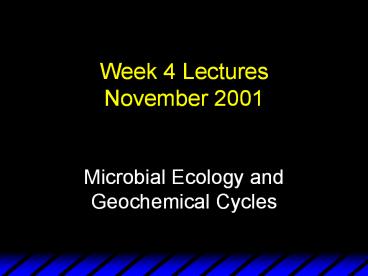Week 4 Lectures November 2001 - PowerPoint PPT Presentation
Title:
Week 4 Lectures November 2001
Description:
Week 4 Lectures November 2001 Microbial Ecology and Geochemical Cycles This Week s Lecture Microbial Ecology Importance of Oxic/Anoxic Environment Geochemical ... – PowerPoint PPT presentation
Number of Views:115
Avg rating:3.0/5.0
Title: Week 4 Lectures November 2001
1
Week 4 LecturesNovember 2001
Microbial Ecology and Geochemical Cycles
2
This Weeks Lecture
- Microbial Ecology
- Importance of Oxic/Anoxic Environment
- Geochemical Cycles
- Applications
3
Microbial Ecology
- Understand the biodiversity of microorganisms and
how different metabolically diverse organisms
interact - Monitor the activities of microorganisms and
their impact on ecosystems
4
Important Terms
- Environment everything surrounding microorganism
including the physical, biological, and chemical
factors that act on the organism - Populations of individual microbial species
- Guilds are metabolically related populations
- The microbial community is made up of guilds
5
Guilds and Communities
- Community 1
- Photic zone
- algae
- cyanobacter
- Community 2 Oxic Zone
- Chemoorganoheterotrophs
- Chemolithoautotrophs
- Guild 1 nitrifiers
- Guild 2 sulfur oxidizing bacteria
- Community 3 Anoxic Zone
- Chemoorganoheterotrophs
- Guild 3 denitrifiers
- Guild 4 sulfate reducers
- Guild 5 fermenters
- Chemolithoautotrophs
- Guild 6 methanogens
- Guild 7 sulfate reducers
6
Microbial Habitats and the Oxic/Anoxic Interface
- Oxygen clearly plays an important role in
determining the range of microbial mediated
reactions that occur in any environment - It is important to understand the relationships
between these two environments and the factors
that lead to the formation of both
7
Oxygen Relationships in Lake Ecosystems
Epilimnion oxygen concentration relatively
uniform and may be as higher as near saturation
Oxic
Thermocline zone of sharp temperature gradient
that separates the epilimnion and hypolimnion
Hypolimnion zone of unmixed water having low
oxygen content
Anoxic
Sediments
8
Oxygen Relationships in Surface Waters (Streams
and Rivers)
9
Oxygen Relationships in Groundwater
- Groundwater constituents that consume oxygen
include - dissolved organic carbon (plant exudates, etc.
- methane
- inorganics
- reduced nitrogen
- reduced iron
- Typically oxygen concentrations decrease with
travel distance
10
Terrestrial Ecosystems
O horizon layer of undecomposed plant material
A horizon surface soil high in organic matter
and high microbial activity
B horizon subsoil minerals and humus leached
from A horizon accumulate, little organic matter
C horizon soil base with low microbial activity
11
Interrelationship Between Moisture Content and
Oxygenation in Soils
- Soils that retain water tend to be more
susceptible to anaerobic conditions - Clays and silts
12
Microenvironments Using Soil as an Example
Distance, mm
Distance, mm
13
Geochemical Cycles
- oxidation/reduction reactions that describe the
changes in an element as it passes through an
ecosystem - geochemical cycles then are of interest for
elements that undergo oxidation/reduction
reactions (C, S, N, Fe, and others) - as shown before, oxygen plays a key role in
metabolic reactions and is a major consideration
in the description of geochemical cycles
14
Carbon Geochemical Cycle
15
Nitrogen Geochemical Cycle
16
Sulfur Geochemical Cycle

